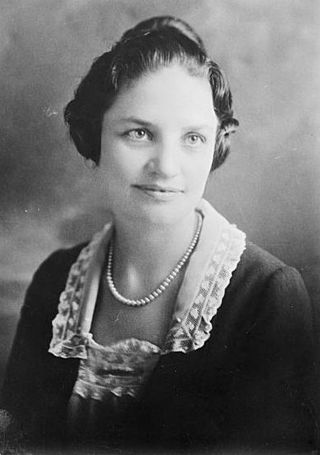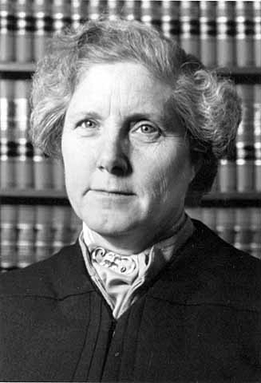Related Research Articles
Epperson v. Arkansas,393 U.S. 97 (1968),was a landmark United States Supreme Court case that invalidated an Arkansas statute prohibiting the teaching of human evolution in the public schools. The Court held that the First Amendment to the United States Constitution prohibits a state from requiring,in the words of the majority opinion,"that teaching and learning must be tailored to the principles or prohibitions of any religious sect or dogma." The Supreme Court declared the Arkansas statute unconstitutional because it violated the Establishment Clause of the First Amendment. After this decision,some jurisdictions passed laws that required the teaching of creation science alongside evolution when evolution was taught. These were also ruled unconstitutional by the Court in the 1987 case Edwards v. Aguillard.

The Minnesota Supreme Court is the highest court in the U.S. state of Minnesota. The court hears cases in the Supreme Court chamber in the Minnesota State Capitol or in the nearby Minnesota Judicial Center.

John Sopinka,was a Canadian lawyer and puisne justice on the Supreme Court of Canada,the first Ukrainian-Canadian appointed to the high court.

William Mitchell College of Law was a private,independent law school located in St. Paul,Minnesota,United States,from 1956 to 2015. Accredited by the American Bar Association (ABA),it offered full- and part-time legal education in pursuit of the Juris Doctor (J.D.) degree. On December 9,2015,Hamline University School of Law merged into William Mitchell College of Law,and became the Mitchell Hamline School of Law.

Christine Meaders Durham is an American lawyer and judge,who served as a justice of the Utah Supreme Court from 1982 to 2017,including service as chief justice from 2002 to 2012.

Myra Colby Bradwell was an American publisher and political activist. She attempted in 1869 to become the first woman to be admitted to the Illinois bar to practice law,but was denied admission by the Illinois Supreme Court in 1870 and the United States Supreme Court in 1873,in rulings upholding a separate women's sphere. Bradwell had founded and published Chicago Legal News from 1868,reporting on the law and continued that work. Meanwhile,influenced by her case,in 1872 the Illinois legislature passed a state law prohibiting gender discrimination in admission to any occupation or profession.

Mabel Walker Willebrandt,popularly known to her contemporaries as the First Lady of Law,was a U.S. Assistant Attorney General from 1921 to 1929,handling cases concerning violations of the Volstead Act,federal taxation,and the Bureau of Federal Prisons during the Prohibition era. For enforcing the Eighteenth Amendment,the prohibition against the manufacture and sale of alcoholic beverages,she also earned herself a nickname “Prohibition Portia”.
Peter Stephen Popovich was an American lawyer,politician,and judge from Minnesota. He is the only person in the state's history to serve as both Chief Judge of the Minnesota Court of Appeals and Chief Justice of the Minnesota Supreme Court.

Sara Rosalie Wahl was an American feminist,lawyer,public defender,clinical law professor,and judge and the first woman to serve on the Minnesota Supreme Court where she served for seventeen years. Governor Perpich nominated Wahl to the Minnesota Supreme Court in 1977 and Wahl won the election to the seat in a non-partisan election in 1978,defeating three male candidates. She chaired the state's Gender Bias Taskforce and Racial Bias Taskforce and led the American Bar Association's efforts to establish clinical legal education. She was a champion for the mentally ill and for displaced homemakers. She wrote 549 opinions including for the majority in holding that different penalties for crack and powder cocaine were unconstitutional in State v. Russell .
Bryan v. Itasca County,426 U.S. 373 (1976),was a case in which the Supreme Court of the United States held that a state did not have the right to assess a tax on the property of a Native American (Indian) living on tribal land absent a specific Congressional grant of authority to do so.

Jill Annette Niederhauser Parrish is an American lawyer who serves as a United States district judge of the United States District Court for the District of Utah. She served as a justice of the Utah Supreme Court from 2003 to 2015.

Maynard E. Pirsig,LLD,was an American legal scholar. He was a professor,and dean,of the University of Minnesota Law School;a Minnesota Supreme Court justice;director of the Minnesota Legal Aid Society,and an advisor for the Indonesian,Puerto Rican,and El Salvadoran legal systems. He defined Legal Ethics in the 1974 Encyclopedia Britannica. His law books were widely used in schools across the country,including his casebook Judicial Administration--which Pirsig used for the United States' first law reform course,early 1930s. He was mentored by Everett Fraser,Roscoe Pound,and Felix Frankfurter.

Lelia Josephine Robinson was the first woman to be admitted to the bar and practice in the courts of Massachusetts in 1882.
Sandra Sue Bailey Gardebring Ogren was an associate justice of the Minnesota Supreme Court appointed by Governor Rudy Perpich in 1991. She also served as Vice President for Institutional Relations at the University of Minnesota,and Vice President for Advancement at California Polytechnic State University following her resignation from the Minnesota Supreme Court in 1998.

Wilhelmina Marie Wright is an inactive senior United States district judge of the United States District Court for the District of Minnesota. She is the only jurist in Minnesota's history to be state district court judge,appellate court judge and state supreme court justice. She was formerly an associate justice of the Minnesota Supreme Court,a judge of the Minnesota Court of Appeals,and a judge of the Minnesota District Court,Second Judicial District.

Esther Hayut is an Israeli jurist who served as president of the Supreme Court of Israel from October 2017 to October 2023.

Reah Mary Whitehead was one of the first female lawyers in Washington state and the first female Justice of the Peace in King County and Washington state.
James Somerville Frazer was an American politician,lawyer,and judge who served in the Indiana House of Representatives and as a justice of the Indiana Supreme Court from January 3,1865 to January 3,1871. Frazer also worked for the Grant administration to help adjust claims made by various parties against the U.S. during the Civil War. Frazer was considered by President Ulysses S. Grant as a potential nominee to the U.S. Supreme Court.
Susanne C. Sedgwick was a legal aid lawyer and judge from Minnesota. She was the first woman Assistant Hennepin County Attorney,the second woman municipal court judge in Minnesota,the first woman Hennepin County District Court Judge,one of the first judges appointed to the newly created Minnesota Court of Appeals,and a contender for the first woman federal district court from Minnesota and the first woman on the Minnesota Supreme Court.
Harriet Lansing is an American lawyer,feminist,and a former judge on the Ramsey County Municipal Court (1978–83) and the Minnesota Court of Appeals (1983–2011).
References
- 1 2 "Biographies of the Justices of the Minnesota Supreme Court". Minnesota State Law Library. Archived from the original on 9 March 2008. Retrieved 19 December 2010.
- 1 2 3 4 5 6 7 Minnesota State Law Library-Esther M. Tomljanovich-Minnesota Associate Supreme Court Justice, 1990-1998
- 1 2 3 Hodder, Douglas G. (1999). "Tribute to Justice Esther Tomljanovich". William Mitchell Law Review. HeinOnline. 25 (4): 1163. Retrieved 19 December 2010.